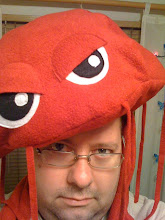
Ray Bradbury's name comes up a second time in 1953, this time a movie from a Saturday Evening Post story. One month after It Came from Outer Space debuts, this movie hits theaters on June 13th. For special effects work the famous stop-motion animator Ray Harryhausen was given his first solo effort in a motion picture. Obviously his effects are rough by today's stands, but this is still cinematic gold and fun to watch.
A government test of a nuclear device in the arctic (strangely called Operation Experiment) wakes up some kind of Dinosaur from its 100,000,000 year hibernation. An Atomic Energy Commission scientist, Tom Nesbitt, sees the monster but is injured. He is taken to New York City to recuperate, where everyone thinks he's nuts and assigns him a couple shrinks. Over a period of weeks several sightings of a sea beast attacking fishing boats and lighthouses emerges. When Nesbitt hears of this he knows it's his creature and sets about getting the head Paleontologist in New York, Professor George Ritchie, on his side. It takes some work but he finally gets the military working with him as well. The Professor shows a pattern of movement for the creature, he dubs a Rhedosaurus, and it is heading for New York City. The beast finally shows up in the harbor and smashes its way through Wall Street, destroying and killing as he goes. When the military gets involved they only wound the creature, and it runs off to hide. The population starts getting sick from some prehistoric virus which kills quickly. This precludes blowing it up so the military decides to use a radioactive shell fired from a rifle into a wound on its neck to kill it from within. The beast chooses to nest inside of a rollercoaster and the military finally hunts it down, killing it in spectacular fashion.
Almost 20 years after King Kong, this has to be the first giant reptile-like creature to stomp through New York City. There was a '40s Fleischer Superman cartoon with a resurrected T-Rex running through the city, but that was an animated Metropolis. This is a almost one-and-a-half years before the first Godzilla. Too bad this didn't spawn any sequels and become the big name its Japanese counterpart did. It would have had to have a proper name and Rhedosaurus doesn't roll off the tongue. I suppose I should nitpick the point that the Beast only woke up because the nuclear blast thawed all his ice, whereas Godzilla is a product of nuclear testing.
The Cassandra Syndrome is in full effect for most of the movie. Nesbitt spends a lot of time trying to convince people he saw something. Even the survivors of attacked fishing boats don't really believe what they see. This tends to be a source of aggravation with me as it allows the writers to drag on the story a little. In Nesbitt's case he is a sympathetic character, who is deservedly relieved when his warnings are finally acted on. There isn't any wasted time with him.
For its time the effects are remarkable effective, mixing the stop-motion scenes with live action. The best is the destruction of the lighthouse. It's not explained well in the story but a lone lighthouse in Maine is operating a fog horn. This attracts the creature because he thinks it's another of his kind. He then climbs the lighthouse to get to the sound and the light, destroying it and the people inside. The effect is great and the exploding wall as the two workers run down the spiral staircase is surprisingly real. There are also iconic scenes of people running down city streets screaming while the creature destroys buildings and stomps cars. A wall even collapses on a group of people that are believably killed.
The addition of the prehistoric germs and viruses is quite ingenious. Not something I think comes up much in Science Fiction until Jurassic Park. In this case anyone who is too close or exposed to its blood, collapse within minutes, dieing sometime after. Unfortunately we don't see a cure in the movie, but presumably after it is killed one is found. The threat of spreading disease everywhere stops the Army from just blowing it up, claiming it would send disease particles everywhere. Strangely they also say you can't burn it because the germs would travel through the smoke into the atmosphere. I don't think that's how it works, but it allows them to use a sniper to use a special one-of-a-kind radioactive bullet.
Dramatically from atop a roller coaster the sniper, Corporal Stone, fires it through a previous wound and the beast dies minutes later. If the bullet was that radioactive it would have killed Stone well before he pulled the trigger. In all the movies I've watched in 1953 the writers really don't have a clear understanding of radiation (probably not their fault), and this movie is no exception. But then everyone smokes in almost every scene of these movies so who am I to judge how the characters react to radiation. And it should be pointed out that Corporal Stone was played by Lee Van Cleef, very young and less than a year after his debut movie High Noon.

No comments:
Post a Comment